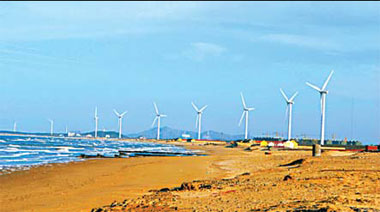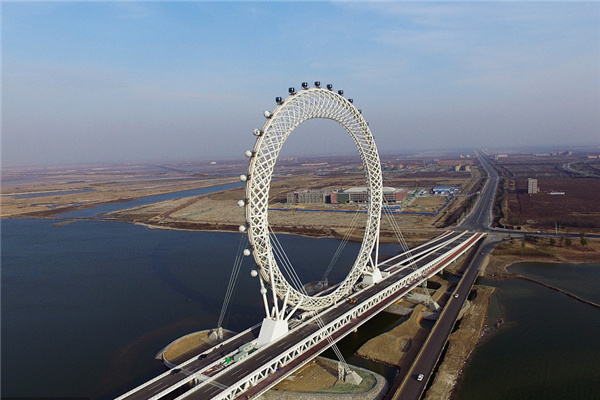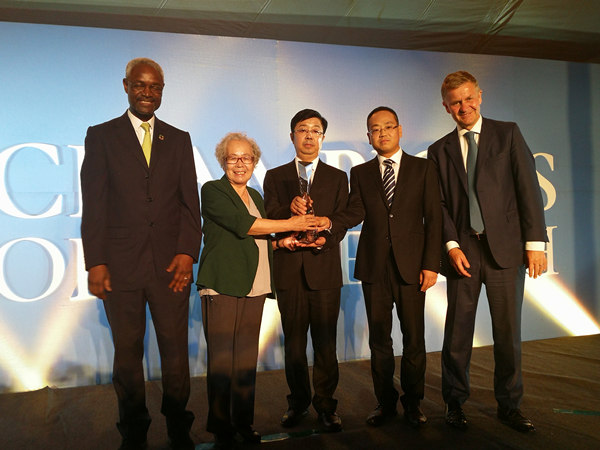

In the northeastern Hainan province city of Wenchang, a 120 megawatts (mW) wind power plant is under construction. It's the first large-scale wind power project in the province with a total investment of 1.3 billion yuan.
The first phase consists of 33 wind turbines, each with the capacity of 1.5 mW. Once operating, they can generate around 103 million kilowatt-hours (kwh) of electricity annually, according to China Huaneng Group, the project's developer.

The Wenchang wind power project is one among Huaneng's many clean-energy projects. Facing soaring oil and coal prices, China's largest power producer is making efforts to adjust its power generation structure.
"We will accelerate the development of clean energy such as hydropower, wind power, solar power and biomass power. By 2010 installed power capacity using these clean energy will increase to 13,000 mW," former Huaneng President Li Xiaopeng tells China Business Weekly.
Huaneng says the development of clean energy can not only save coal consumption but also benefit the environment. "Take the Wenchang wind power project for example, compared with coal-fired power plant with the same capacity, it can save over 35,000 tons of coal equivalent in a year," says Li.
Besides Hainan, the company is developing wind power plants in provinces such as Guangdong, Jilin, Shandong and Inner Mongolia. At present the company's wind power projects in operation or under construction have a combined capacity of over 1,300 mW, says Li.
Huaneng is also quickening its development of hydropower and nuclear power. It is now constructing several hydropower projects on the Lancang River in Yunnan, with total capacity of 15,000 mW. The company is also planning China's first nuclear power project using high-temperature gas-cooled technology. With an investment of 3 billion yuan, its 200-mW Shidaowan nuclear power plant in Rongcheng in Shandong is expected to start construction in 2009.
"Clean energy power generation will become a new growing force for our business," says Li.
Apart from diversifying energy sources, Huaneng is also taking part in some other non-power generation businesses to relieve the pressure of rising costs. Non-power generation businesses account for 12.88 percent of the company's portfolio, with financial businesses taking up 7.96 percent.
Because of its diversified businesses, in the first quarter Huaneng saw an overall profit of 150 million yuan, in spite of the skyrocketing coal prices.
In the first quarter the company generated 89.5 billion kwh of electricity, 11.1 percent of China's total.
However, China's four other major power companies, China Datang Corp, China Guodian Corp, China Huadian Corp, China Power Investment Corp all saw losses in the first three months.
Coal business
Coal-fired power plants account for most of Huaneng's business. And to cope with the rising prices of raw material, the company is increasing its share of the coal mining business.
This March Huaneng signed an agreement with Gansu province to expand co-operation in the energy field. Under the agreement Huaneng will invest over 60 billion yuan to develop coal, power, railway and chemical projects in the province.
In 2007 the company set up Huaneng Hulunbeir Energy Co. Located in eastern Inner Mongolia, the company has annual coal production capacity of 16.78 million tons.
Huaneng is eyeing abundant coal reserves in west China to increase its production. The company plans to take part in some coal projects in Shaanxi, Ningxia and Xinjiang, sources with the company said earlier.
The company is also considering some investments in overseas coalmines, such as in Australia, said sources.
Huaneng plans to increase its coal production from 17 million tons in 2007 to 45 million tons in 2007. By that year the company's coal output can satisfy 20 percent of its overall consumption, says Hu Shihai, assistant to the president of Huaneng.
Going overseas
Overseas development is also a strategy Huaneng uses to improve its competency. In 2003 Huaneng paid $227 million to buy 50 percent stake of OzGen in Australia, which was the first time for a Chinese power company to tap into foreign power market.
By the end of 2007 it had realized a $47 million profit from the project, says the company.
"Going overseas, we will not only get assets with good quality, we can also learn new technologies and management techniques," says Li Xiaopeng.
In March the company bought Singapore's Tuas Power Ltd for S$4.24 billion ($3 billion) from Temasek Holdings, an Asia investment house headquartered in Singapore.
With it, Huaneng will have the 2,670 mW electricity-generating capacity of Tuas. This accounts for over 25 percent of the power manufacturing market share in Singapore, the company says.
(China Daily 06/09/2008 page3)













